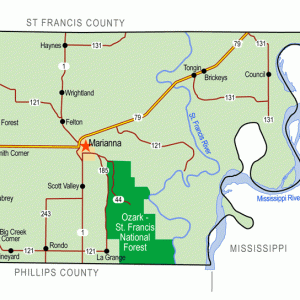calsfoundation@cals.org
Raggio (Lee County)
The town of Raggio existed briefly on the east bank of Alligator Bayou, about a mile from the St. Francis River, in Lee County. A logging community that was served by the railroad, the town was destroyed by fire around 1916 and was never rebuilt.
Until after the Civil War, the site that would become Raggio was largely unclaimed wetland with abundant trees. Hunting and fishing occupied the few visitors to the area, and steamboats traveled the river. Following the war, a logging settlement was established at Raggio; the community was named for a local merchant who had come to Arkansas from Italy. Logs were bound together as rafts to be transported by water to sawmills. Shortly after Lee County was created, a post office was established in 1875; it bore the names Park Place and Raggio. The town was not incorporated until 1907, around the time that a railroad bridge was built by the Missouri Pacific Railroad to cross the St. Francis River near Raggio.
According to a resident of the town, at the time it was incorporated, Raggio consisted of a long row of drab, unpainted shacks. The town had one store and an African-American church, as well as the post office. Gunfights and other violence were common in the town. More stores, restaurants, and saloons were built with the coming of the railroad, as well as additional houses. According to the 1910 census, the population of Raggio that year was sixty-five.
A fire around 1916 destroyed much of the town, sparing only three houses. These were abandoned and allowed to collapse. Mail service was rerouted to Brickeys (Lee County). Farms were later established on the land near Raggio, which had been cleared of trees. In 1992, the Arkansas Department of Correction established a facility, the East Arkansas Regional Unit, at Brickeys.
For additional information:
Lee County Sesquicentennial Committee. Lee County History. Dallas, TX: Curtis Media Company, 1987.
Steven Teske
Butler Center for Arkansas Studies
 Lee County Map
Lee County Map 




Comments
No comments on this entry yet.